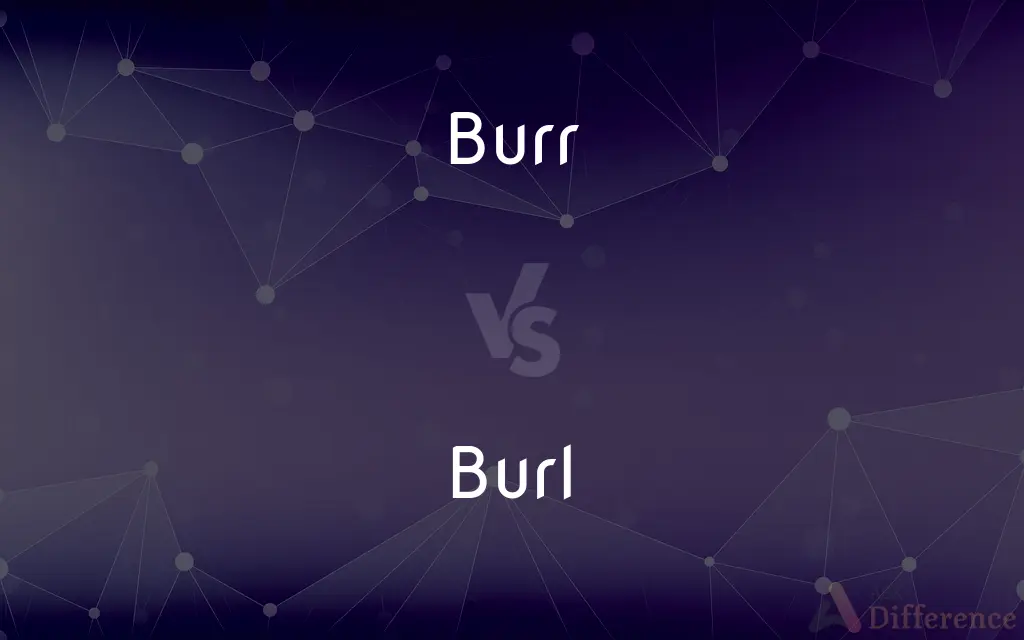Burr vs. Burl — What's the Difference?
By Tayyaba Rehman & Maham Liaqat — Updated on April 5, 2024
A burr is a rough edge left on metal after cutting or drilling, while a burl is a tree growth with dense, twisted grain.

Difference Between Burr and Burl
Table of Contents
ADVERTISEMENT
Key Differences
A burr in the context of metalworking or woodworking refers to the sharp, rough edges or protrusions left on a material after it has been cut, drilled, or otherwise machined. These edges can interfere with the functionality of the part, potentially causing injury or wear in mechanical systems, necessitating their removal through a process called deburring. In contrast, a burl is a unique growth on the trunk or branch of a tree, characterized by its highly dense and twisted wood grain. Burls result from stress or injury to the tree and are highly valued in woodworking and artistic communities for their aesthetic appeal and the distinctive patterns they create when cut and polished.
Burr formation is often considered undesirable in manufacturing and craftsmanship, as it can affect the precision, performance, and safety of mechanical components and assemblies. The removal of burrs is a critical finishing step in the production process. On the other hand, burls are sought after for their beauty and rarity. The wood from burls is used in veneers, furniture, and sculptural pieces, prized for its unique appearance and the depth it adds to finished products.
The occurrence of burrs is largely preventable or minimizable through careful machining practices and the use of sharp, properly maintained tools. However, the formation of burls on trees is unpredictable and cannot be intentionally induced, making burl wood rare and often expensive. The value of burl wood lies in its distinctiveness and the skill required to work with its complex grain patterns.
While burrs are removed to improve the function and safety of items, burls are preserved and highlighted in wood products for their aesthetic qualities. This distinction underscores the different values and treatments these features receive in their respective fields. The craftsmanship involved in handling both burrs and burls showcases the attention to detail and the appreciation of material characteristics that define quality workmanship.
Despite their differences, both burrs and burls reflect the impact of external forces on materials—whether through human action in machining or natural processes in tree growth. They serve as reminders of the interplay between creation and imperfection, and the potential for beauty or functionality that can emerge from addressing or embracing these imperfections.
ADVERTISEMENT
Comparison Chart
Definition
A rough edge or area on metal after machining.
A growth on a tree with dense, twisted grain.
Origin
Result of cutting, drilling, or machining processes.
Caused by stress, injury, or infection in trees.
Desirability
Generally undesirable, requiring removal.
Highly prized for its unique beauty and grain.
Use
Removal improves safety and functionality of parts.
Used in decorative woodwork and art for its aesthetic.
Value
Considered a flaw in metalworking.
Adds significant value to wood products.
Compare with Definitions
Burr
Can affect the performance and wear of mechanical systems.
A burr left on a gear could cause it to wear prematurely.
Burl
Prized for its unique patterns and rarity.
Burl wood is sought after for high-end veneers and artistic projects.
Burr
Essential for safety and functionality, often requiring specialized tools.
Deburring tools are used to smooth out the rough edges left after machining.
Burl
Adds depth and interest to wood products.
The table made from burl wood became the centerpiece of the room, admired for its intricate grain.
Burr
Occurs as a result of metalworking processes like cutting or drilling.
Drilling often leaves a burr that must be deburred for a smooth finish.
Burl
Arises from tree stress or injury, resulting in a highly figured wood grain.
The burl was likely caused by an injury to the tree many years ago.
Burr
A sharp, protruding edge left on a piece of metal after machining.
The machinist carefully removed the burr from the metal part to prevent injury.
Burl
A tree growth where the grain has grown in a deformed manner.
The cabinetmaker found a beautiful burl in the forest and envisioned a stunning piece of furniture.
Burr
Designers must account for burr formation in manufacturing processes.
The product's design included allowances for deburring to ensure assembly precision.
Burl
Requires special care due to its irregular grain.
Turning a burl on a lathe demands a skilled hand to manage its unpredictable grain.
Burr
A rough edge or area remaining on material, such as metal, after it has been cast, cut, or drilled.
Burl
A burl (American English) or burr (British English) is a tree growth in which the grain has grown in a deformed manner. It is commonly found in the form of a rounded outgrowth on a tree trunk or branch that is filled with small knots from dormant buds.
Burr
Variant of bur1.
Burl
A knot, lump, or slub in yarn or cloth.
Burr
A trilling of the letter r, usually made with the tip of the tongue and characteristic of Scottish speech.
Burl
A large rounded outgrowth on the trunk or branch of a tree.
Burr
A buzzing or whirring sound.
Burl
The wood cut from such an outgrowth, often used decoratively as a veneer.
Burr
A washer that fits around the smaller end of a rivet.
Burl
To dress or finish (cloth) by removing knots, lumps, slubs, or loose threads.
Burr
To form a burr on.
Burl
A tree growth in which the grain has grown in a deformed manner; a burr knot.
Burr
To remove burrs from.
Burl
Wood of a mottled veneer, usually cut from such a growth.
Burr
To pronounce with a burr.
Burl
A knot or lump in thread or cloth.
Burr
To speak with a burr.
Burl
To remove the knots in cloth.
Burr
To make a buzzing or whirring sound.
Burl
To dress or finish up (cloth); to pick knots, burs, loose threads, etc., from, as in finishing cloth.
Burr
A sharp, pointy object, such as a sliver or splinter.
Burl
A knot or lump in thread or cloth.
Burr
A bur; a seed pod with sharp features that stick in fur or clothing.
Burl
An overgrown knot, or an excrescence, on a tree; also, veneer made from such excrescences.
Burr
A small piece of material left on an edge after a cutting operation.
Burl
The wood cut from a tree burl or outgrowth; often used decoratively in veneer
Burr
A thin flat piece of metal, formed from a sheet by punching; a small washer put on the end of a rivet before it is swaged down.
Burl
A large rounded outgrowth on the trunk or branch of a tree
Burr
A broad iron ring on a tilting lance just below the grip, to prevent the hand from slipping.
Burl
Soft lump or unevenness in a yarn; either an imperfection or created by design
Burr
The ear lobe.
Burl
Remove the burls from cloth
Burr
A burr knot or burl.
Burr
The knot at the bottom of an antler.
Burr
(engineering) A revolving disk or cone with abrasive surfaces used to grind hard products in a grinder or mill.
Burr
A rough humming sound.
Burr
A uvular "r" sound, or (by extension) an accent characterized by this sound.
Burr
(historic) A metal ring at the top of the hand-rest on a spear.
Burr
(British) burl
Burr
(transitive) To pronounce with a uvular "r".
Burr
(intransitive) To make a rough humming sound.
Burr
A prickly seed vessel. See Bur, 1.
Burr
The thin edge or ridge left by a tool in cutting or shaping metal, as in turning, engraving, pressing, etc.; also, the rough neck left on a bullet in casting.
The graver, in plowing furrows in the surface of the copper, raises corresponding ridges or burrs.
Burr
A thin flat piece of metal, formed from a sheet by punching; a small washer put on the end of a rivet before it is swaged down.
Burr
A broad iron ring on a tilting lance just below the gripe, to prevent the hand from slipping.
Burr
The lobe or lap of the ear.
Burr
A guttural pronounciation of the letter r, produced by trilling the extremity of the soft palate against the back part of the tongue; rotacism; - often called the Newcastle burr, Northumberland burr, or Tweedside burr.
Burr
To speak with burr; to make a hoarse or guttural murmur.
Burr
Seed vessel having hooks or prickles
Burr
Rough projection left on a workpiece after drilling or cutting
Burr
United States politician who served as Vice President under Jefferson; he mortally wounded his political rival Alexander Hamilton in a duel and fled south (1756-1836)
Burr
Rotary file for smoothing rough edges left on a workpiece
Burr
Small bit used in dentistry or surgery
Burr
Remove the burrs from
Common Curiosities
What is a burr?
A burr is a rough edge or protrusion left on metal after machining, which can affect functionality and safety.
What causes a burl on a tree?
Burls are caused by stress, injury, or infection, leading to abnormal growth and grain patterns in the wood.
Why is burl wood valued?
Burl wood is valued for its unique, intricate patterns and rarity, making it desirable for decorative and artistic use.
Can burls be cultivated?
Burls cannot be intentionally cultivated as their formation is due to unpredictable stress factors on trees.
What are the implications of not removing burrs from metal parts?
Not removing burrs can lead to injury, wear in mechanical systems, and impair the fit and function of assembled parts.
Is every burl unique?
Yes, each burl is unique due to its natural formation process, resulting in one-of-a-kind grain patterns and textures.
How are burrs removed?
Burrs are removed through a process called deburring, using tools designed to smooth and finish metal surfaces.
What industries are concerned with burr formation?
Industries involved in metalworking, manufacturing, and engineering are concerned with burr formation and removal.
Can burrs form on materials other than metal?
Yes, burrs can also form on wood and plastic during machining processes, though they are most commonly associated with metal.
How do you work with burl wood?
Working with burl wood requires skill and patience due to its unpredictable grain, often involving special tools and techniques.
Are there any benefits to the tree from forming a burl?
There's no direct benefit to the tree; burls are a response to stress or injury rather than a beneficial adaptation.
Why might a designer need to consider burr formation?
Designers must consider burr formation to ensure that parts can be assembled correctly and function as intended.
What makes burl wood difficult to work with?
The irregular, twisted grain of burl wood can be challenging to cut and shape without the right tools and expertise.
Share Your Discovery

Previous Comparison
Subheading vs. Heading
Next Comparison
Dimple vs. PuckerAuthor Spotlight
Written by
Tayyaba RehmanTayyaba Rehman is a distinguished writer, currently serving as a primary contributor to askdifference.com. As a researcher in semantics and etymology, Tayyaba's passion for the complexity of languages and their distinctions has found a perfect home on the platform. Tayyaba delves into the intricacies of language, distinguishing between commonly confused words and phrases, thereby providing clarity for readers worldwide.
Co-written by
Maham Liaqat













































